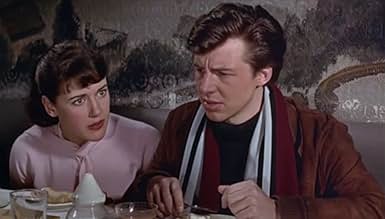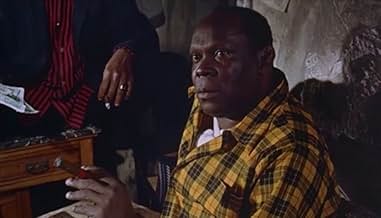IMDb-BEWERTUNG
7,2/10
2765
IHRE BEWERTUNG
Füge eine Handlung in deiner Sprache hinzuThe murder of a young woman in London exposes deep racial tensions and prejudices inherent in the area.The murder of a young woman in London exposes deep racial tensions and prejudices inherent in the area.The murder of a young woman in London exposes deep racial tensions and prejudices inherent in the area.
- Regie
- Drehbuch
- Hauptbesetzung
- 1 BAFTA Award gewonnen
- 3 Gewinne & 4 Nominierungen insgesamt
Thomas Baptiste
- Man on the Street
- (Nicht genannt)
Victor Brooks
- Police Sergeant
- (Nicht genannt)
Marie Burke
- Second landlady
- (Nicht genannt)
Empfohlene Bewertungen
The real problem with television broadcasting is that the better movies of the last century are held from the viewers. SAPPHIRE could be shown as a double bill with AN INSPECTOR CALLS. There are not enough movie buffs to push some of these classics so that they can be shown to today's audiences ..which would really appreciate them.
SAPPHIRE (UK 1959) takes a honest and brutally realistic approach to racism: it exists in everyone, white, black or of mixed race. Sadly, that continues to be the case today even if now intermarriage is more acceptable and no longer prevents people renting accommodation, joining creches or schools, and it is less visibly frowned upon.
Director Basil Dearden had already distinguished himself with social comment films as THE BLUE LAMP (UK 1950), in which Dirk Bogarde plays an unrepentant criminal hunted by police in postwar London, THE SQUARE RING (UK 1953), which does not pull any punches analyzing the brutality of boxing and of the people in it, and VIOLENT PLAYGROUND (UK 1958), an ongoing duel between police and an arsonist.
Pity that six decades later racism remains a problem everywhere, and the movie industry, and life in general, continues to try to address that problem with the mendacity of political correctness.
SAPPHIRE does well to show how limited we, the human race, are in dealing with that issue. Even policemen like Learoyd (Michael Craig) are racist at heart, so there is an institutional side to the problem, too.
Direction is very good, although it allows characterization to go over the top in some cases; color photography is outstanding; screenplay is concise and objective; and acting reflects the high competence for which British filmmaking of the 1940s-1960s period was famous for, although I thought Yvonne Mitchell a little bit too unnecessarily hysterical in the key scene in which Sapphire's dark-skinned brother handles a child's doll.
Nigel Patrick's acting is particularly praiseworthy. Detective Hazard (odd surname, nothing hazardous about his character or actions) is an extremely professional, restrained, and experienced policeman standing as the emotional stabilizer in a film of many social and racial angles. He is seldom critical, he just wants justice done regardless of who must pay.
In light of mankind's above mentioned limitations, I suppose that, however incomplete, the pursuit of justice is the best, most practical solution to the continuing problem of racism in today's society, and it is to this film's credit that it highlights it at a time when the UK was beginning to receive a large number of people of other races from its former colonies.
In some ways, SAPPHIRE is well ahead of its time, and it remains very much up to date today.
Director Basil Dearden had already distinguished himself with social comment films as THE BLUE LAMP (UK 1950), in which Dirk Bogarde plays an unrepentant criminal hunted by police in postwar London, THE SQUARE RING (UK 1953), which does not pull any punches analyzing the brutality of boxing and of the people in it, and VIOLENT PLAYGROUND (UK 1958), an ongoing duel between police and an arsonist.
Pity that six decades later racism remains a problem everywhere, and the movie industry, and life in general, continues to try to address that problem with the mendacity of political correctness.
SAPPHIRE does well to show how limited we, the human race, are in dealing with that issue. Even policemen like Learoyd (Michael Craig) are racist at heart, so there is an institutional side to the problem, too.
Direction is very good, although it allows characterization to go over the top in some cases; color photography is outstanding; screenplay is concise and objective; and acting reflects the high competence for which British filmmaking of the 1940s-1960s period was famous for, although I thought Yvonne Mitchell a little bit too unnecessarily hysterical in the key scene in which Sapphire's dark-skinned brother handles a child's doll.
Nigel Patrick's acting is particularly praiseworthy. Detective Hazard (odd surname, nothing hazardous about his character or actions) is an extremely professional, restrained, and experienced policeman standing as the emotional stabilizer in a film of many social and racial angles. He is seldom critical, he just wants justice done regardless of who must pay.
In light of mankind's above mentioned limitations, I suppose that, however incomplete, the pursuit of justice is the best, most practical solution to the continuing problem of racism in today's society, and it is to this film's credit that it highlights it at a time when the UK was beginning to receive a large number of people of other races from its former colonies.
In some ways, SAPPHIRE is well ahead of its time, and it remains very much up to date today.
When a young woman's body is discovered on London's Hampstead Heath, the ensuing investigation quickly focuses on racial bigotry and hatred in 1950s Britain, exposing the prejudice amongst those under investigation AND those investigating.
Like so many other films from the 1940s and 1950s, Sapphire is yet another piece of groundbreaking British cinema now long forgotten. A little clunky and overly reliant on stereotyping by today's standards, but still a fascinating exploration of the fears and struggles inherent in a newly mixed-race society. Dearden has brought together an interesting cast here, cleverly giving matinée idol Craig a fairly unsympathetic role as a racist police officer, and being superbly served by Mitchell - her final scene is at once both compelling and distressing. Too many British cinema actors of the 40's and 50's have now been forgotten, and Mitchell is a prime example of why individual and collective reappraisals and retrospectives are long overdue.
Interesting companion piece to 1961's Flame In The Streets, then, and definitely worth catching if you can.
Like so many other films from the 1940s and 1950s, Sapphire is yet another piece of groundbreaking British cinema now long forgotten. A little clunky and overly reliant on stereotyping by today's standards, but still a fascinating exploration of the fears and struggles inherent in a newly mixed-race society. Dearden has brought together an interesting cast here, cleverly giving matinée idol Craig a fairly unsympathetic role as a racist police officer, and being superbly served by Mitchell - her final scene is at once both compelling and distressing. Too many British cinema actors of the 40's and 50's have now been forgotten, and Mitchell is a prime example of why individual and collective reappraisals and retrospectives are long overdue.
Interesting companion piece to 1961's Flame In The Streets, then, and definitely worth catching if you can.
I'm watching this 60 years after it was filmed, and I'm saying to myself: "This movie might as well have been premiered yesterday!"
Sure, it has that old style "whodunnit" feel to it, and sure it is dated by musical and fashion standards (and by next-to-zero traffic in Sheppard's Bush), but it is assuredly a solid piece of Cinema which at the same time tackles pressing societal issues.
On another note, it struck me as an outstanding piece of "britishness", as opposed to the usual USA-style murder/mystery/thriller because of:
1) A couple of children and a woman find the dead body, but there are no hysterical shrieks;
2) Everybody is polite, even the bandits;
3) No shots are fired;
...which is also a reminder that a good thriller doesn't necessarily require action-packed sequences of gunshots and fistfights.
So who killed Sapphire. That's the movie's plot; however, the underlying theme is racial prejudice, a generally touchy topic at the time, even for British films. As I recall, the movie got more coverage than usual for a foreign release, at least in the LA area. The lovely Sapphire may look White, but genetically she's half-Black. Her troubles start when she "passes for White" in a London society still riven by prejudice. Engaged to the son of a reputable White family, her racial make-up causes rifts within the circle once her heritage is known. Naturally, the suspects start off with the family of her intended.
The twin threads of race and murder are skillfully woven into a difficult screenplay that nevertheless compels attention from start to finish. Credit a highly efficient performance from Nigel Patrick for holding together the disparate elements as his chief investigator works his way through London's many precincts. I like the way the screenplay portrays levels of racial dislike from both Whites and Blacks without getting too judgmental. Also, it looks like the exteriors were shot on location without any prettifying. Some of the neighborhoods in fact amount to about the last word in urban decay. Happily, director Deardon keeps things moving in unobtrusive fashion right down to the rather surprising finish. Anyway, the 90-some minutes amount to a topically compelling package that deserved its initial hoopla and still does.
The twin threads of race and murder are skillfully woven into a difficult screenplay that nevertheless compels attention from start to finish. Credit a highly efficient performance from Nigel Patrick for holding together the disparate elements as his chief investigator works his way through London's many precincts. I like the way the screenplay portrays levels of racial dislike from both Whites and Blacks without getting too judgmental. Also, it looks like the exteriors were shot on location without any prettifying. Some of the neighborhoods in fact amount to about the last word in urban decay. Happily, director Deardon keeps things moving in unobtrusive fashion right down to the rather surprising finish. Anyway, the 90-some minutes amount to a topically compelling package that deserved its initial hoopla and still does.
Wusstest du schon
- WissenswertesThe success of this movie, in spite of its controversial themes, encouraged Janet Green to write Teufelskreis (1961), and Basil Dearden to direct it.
- PatzerThe ripped photo used as a clue appears in two versions from the first time it's discovered. The first version shows Sapphire laughing as she dances, with her mouth open. The second shows her smiling broadly with her jaw closed.
- Zitate
[last lines]
Superintendent Robert Hazard: We didn't solve anything, Phil. We just picked up the pieces.
Top-Auswahl
Melde dich zum Bewerten an und greife auf die Watchlist für personalisierte Empfehlungen zu.
- How long is Sapphire?Powered by Alexa
Details
Box Office
- Budget
- 400.000 $ (geschätzt)
- Laufzeit1 Stunde 32 Minuten
- Seitenverhältnis
- 1.66 : 1
Zu dieser Seite beitragen
Bearbeitung vorschlagen oder fehlenden Inhalt hinzufügen

Oberste Lücke
By what name was Das Mädchen Saphir (1959) officially released in India in English?
Antwort






























